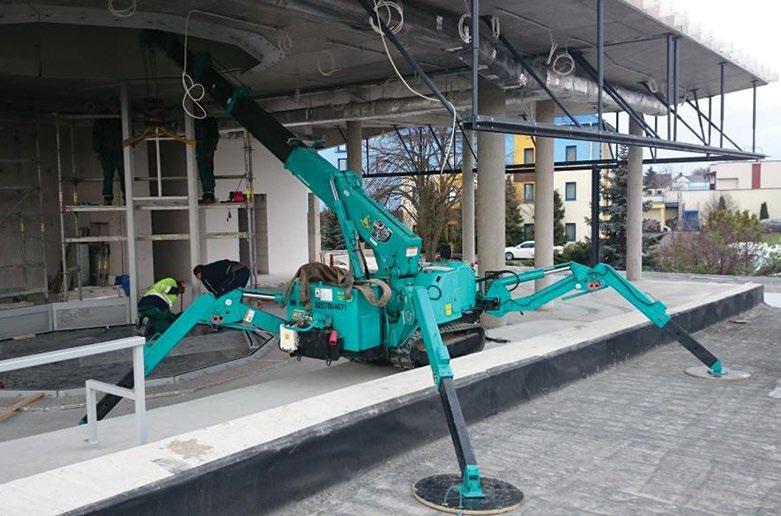
5 minute read
Spiders spreading
Spiders spreading
It is just over 40 years since Japanese loader crane manufacturer and Komatsu distributor Maeda introduced one of the world’s first spider cranes, the CP 150. The concept combined one of its telescopic booms with the spider leg outrigger concept first seen on the Falck Schmidt spider lift, and a compact Komatsu style tracked chassis.
The result was an ultra-compact crane that could squeeze into and set up in the tightest of spaces, carrying out work previously done with block and tackle or a larger crane working from a distance. Maeda continued to develop the concept, with the arrival of the MC264HC in 1989 and MC354C in 1990, both of which are similar to the products offered today.

R&B Engineering, which builds the Mighty Crane, claims to have introduced its first spider crane a few months earlier than Maeda, with a product aimed at the stone and quarry industry, although details are limited. The other big Japanese spider crane manufacturer Furukawa/Unic has a similar background to Maeda having started with telescopic loader cranes, before introducing its first spider cranes in the early 1990s.


Spiders arrive in Europe
Spider cranes first appeared in Europe in 1999 when Kranlyft, the Kato distributor at the time, introduced Maeda. Prices were high and sales limited to a few niche buyers. Glass handling specialist GGR purchased some of them for its glass handling work, and sensing the potential, began looking for its own spider crane brand. It soon found Furukawa/Unic and purchased a few units, in spite of the fact that Unic had no interest in CE certification. Having evaluated the product, GGR set about doing its own CE type approval. As a result, it was appointed the Unic master distributor for Europe, Africa and the Middle East. With two manufacturers now on the market and GGR adding them to its rental fleet, the concept began to take off, initially in the UK and then the rest of Europe.


Th Italian job
At the same time, Italian loader crane distributor and body builder Ormet launched a spider crane to meet the needs of Italian glass and curtain walling contractors working around the world. Built by its Imai man basket manufacturing division, the first units were horribly unreliable and looked like something the village blacksmith had turned out, when compared to the Japanese built products. In the words of one major contractor using Imai cranes on high rise building projects in London: “They are absolutely brilliant, but you need a full time mechanic with them!”
The Jekko name was adopted around 2007 for the first series production models, which were far better, but still a tad rustic. By 2010 the cranes had improved significantly, at the same time its innovative and detail engineering became world class, with each model better than the last. This time last year the company celebrated the production of its 2,000th crane. In the meantime, the Japanese manufactures have been slow to innovate, although their products are easy to use and absolutely bulletproof in terms of reliability.

Second Eco for Maeda
Today the key focus is on battery powered models, Maeda launched its 2.82 tonne MC285C-3 last year and unveiled the larger 2.98 tonne MC305CB-3 at Vertikal Days. Rated at 2.5 metres it features a five section main boom for a maximum tip height of 13.5 metres. It manages 790kg on the fully extended boom or 260kg at a 12.1 metre radius. Power comes from 55 volt 180Ah lithium-ion battery pack, said to provide up to 14 hours of lifting operations. It can be fully charged in 4.5 hours, or to 80 percent in three hours. White non-marking tracks are standard, while options include black tracks, radio remote controls, a single fall hook and 850kg or 1,500kg searcher hooks.

Big lithium Jekko
Jekko unveiled a lithium powered version of its eight tonne SPX1280 spider crane in July. It uses a 20kW electric motor and a 96 volt/400Ah lithium-ion battery pack. A dual voltage - 230 volt single phase or 400 volt three phase - onboard charger is standard, and the machine can also work while being charged. It features a five section 17.7 metre main boom plus a range of jibs including a 3.5 tonne searcher jib and a 7.6 metre four section hydraulic jib that provides a maximum tip height of 26.6 metres.

Early to the market
GGR/Unic was very early to the market, unveiling its wheeled 0.995 tonne Eco-095 and 2.9 tonne capacity Eco-295 in April 2013. Powered by a more traditional 48 volt battery pack they offered 2.5 hours of continuous operation, still sufficient for many applications. It followed with tracked versions of both cranes in 2018.



Dutch range all ‘e’
Another manufacturer that has developed substantially in recent years is Dutch manufacturer Hoeflon. As with Jekko, its ‘fit and finish’ now matches that of the Japanese products and it is also developing a strong reputation for ground breaking product development. It announced its highly innovative nine tonne C30e electric machine in 2019 and followed up with the fully electric three tonne C6e spider crane last year. The new model features a five section 11.5 metre main boom and a 4.3 metre hydraulic luffing jib to offer a maximum tip height of 17 metres. It is powered by a lithium phosphate battery pack, and can run at 60 percent utilisation for up to eight hours before requiring a re-charge. It can also operate while plugged into mains power, topping up the battery pack while in use. The smaller two tonne C4e is also available as an all electric crane with a similar power pack to the C6e.
The other major spider crane trend is the move towards larger articulated models.











